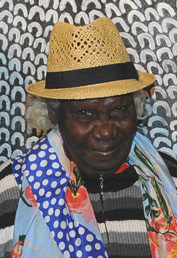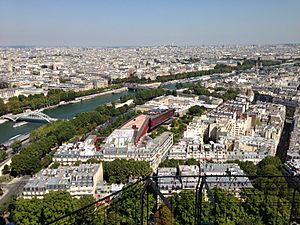Lena Nyadbi facts for kids
Quick facts for kids
Lena Nyadbi
|
|
|---|---|

Lena Nyadbi standing in front of her most notable work, Dayiwul Lirlmim (Paris, June 2013)
|
|
| Born | circa 1936 Warnmarnjulugun lagoon, Western Australia
|
| Nationality | Indigenous Australian |
| Known for | Painting, installation art |
|
Notable work
|
Dayiwul Lirlmim |
Lena Nyadbi AO (born c. 1936) is an amazing contemporary Indigenous Australian artist. She comes from the Warmun Community in the Kimberley region of Western Australia. Her most famous artwork is Dayiwul Lirlmim. Parts of this painting were put on the roof of the Musée du quai Branly in Paris. This huge artwork can only be seen from high up, like from the Eiffel Tower or on Google Earth.
Contents
Lena Nyadbi's Early Life
Lena Nyadbi was born around 1936 near a lagoon called Warnmarnjulugun in Western Australia. She belongs to the Gija people. Lena's parents passed away when she was young. Her older sister, Goody Barrett, then raised her on a cattle station.
From a young age, Lena worked on cattle stations in the area. She learned how to milk cows and ride horses. She also helped with gathering cattle. In 1968, a new rule meant that Indigenous workers on cattle stations would get paid the same as others. Because of this, Lena and many Gija people moved to the Warmun Community. In the 1970s, the Warmun Art Movement started. Lena lived among famous artists like Rover Thomas and Queenie McKenzie during this time.
Lena Nyadbi's Artistic Journey

In 1998, Lena Nyadbi started painting full-time. This was the same year the Warmun Art Centre opened. Lena had spent many years watching and learning from other artists in Warmun. Her teacher, Paddy Jaminji, showed her how to prepare natural materials. She learned to grind ochre (a natural earth pigment) and charcoal to make paints. She used her hands to apply the charcoal onto the canvas.
Ochre has been a key material in Aboriginal Australian art for thousands of years. Artists use it to paint important dreamtime stories. Because ochre has a limited range of colors, Lena's artworks often have similar color schemes. This allows artists to focus on how colors work together. Lena makes her own paints. Her art is known for its "rich, simple beauty" and strong contrasting colors. She often uses repeated symbols that connect to her family's stories.
Lena usually paints two main dreaming stories, called ngarranggarni in the Gija language. These are the Jimbirlam Ngarranggarni (Spearhead Dreaming) and Dayiwul Lirlmim Ngarranggarni (Barramundi Scales Dreaming). Her Spearhead Dreaming paintings tell stories about her father's country. Her Barramundi Scales Dreaming works tell stories about her mother's land. This land is where the Argyle Diamond Mine is located. In her paintings, vertical lines often show Spearhead Dreaming. Semi-circular shapes often show Barramundi Dreaming.
In 2002, the director of the Musée du quai Branly in Paris, Stéphane Martin, wanted to display Indigenous Australian art. He worked with the museum's architect, Jean Nouvel, and the French President. They asked the Australian government to find artists whose work could be shown on the museum's walls, windows, and ceilings. Eight Aboriginal artists were chosen for this special project, and Lena Nyadbi was one of them.
One of Lena's pieces, Jimbirlam and Kumerra, was chosen for an outside wall. This artwork means Spearheads and Scarifications. It was originally black and white. The museum decided to change it to grey-on-grey to match the buildings nearby. Lena initially did not like the early designs for the wall. She felt they lacked contrast and made her art look strange. Her concerns almost led to her leaving the project. However, the final artwork is now on an outer wall of the museum. You can see it from rue de l'Université.
The Story Behind Hideout
Lena Nyadbi's 2002 painting Hideout tells a powerful family story. It shows a time when her family had to hide in a cave. They were escaping from people who were chasing them. This was a story Lena heard often as she grew up. Her family eventually found another way out of the cave. They climbed to a ridge and watched as the "gadiya" (white people) searched for them.
The bottom part of Hideout shows the cave where her family hid. It also shows a nearby place important to an ancestral bat. There is also a gathering spot where Gija people would prepare food. Hideout mostly uses black and white ochre. But it also has a line of red spearheads in the top half. Lena's use of symbols and different places in her art connects the past, present, and ancestral times.
Dayiwul Lirlmim: Art on a Rooftop
In 2011, Stéphane Martin, the museum director, had an idea. He wanted to turn part of the museum's roof into a display of Aboriginal art. This would continue the museum's tradition of featuring Indigenous art. Harold Mitchell, a supporter of the arts, saw a great chance to show Aboriginal art to more people. The roof could be seen from the Eiffel Tower! He agreed to help.
A special committee, including art curator Hetti Perkins, suggested Lena Nyadbi's work. They felt her art would be perfect for the museum's roof. The museum building is shaped like a fish and is next to the Seine River. Lena's Barramundi scales artwork fit this idea perfectly.
The project cost AU$500,000. Lena created a work called Dayiwul Lirlmim, which means Barramundi scales. This artwork tells a dreaming story about three women who try to catch a barramundi fish. The fish escapes and jumps across a creek onto rocks. Scales from the fish scatter across the land. These scales represent the diamonds found at the Argyle Diamond Mine, which is on Lena's traditional lands. Lena used ochre and charcoal from her own land to create the painting. Harold Mitchell bought the painting and loaned it to the museum for a long time.

To put the artwork on the roof, the original painting was first scanned into a computer. This allowed them to create 172 stencils, each measuring 3 meters by 1.5 meters. These stencils were then used to paint the design onto the roof. They used a special white rubber paint, like the one used for traffic signs in Paris. Scanning the painting also means it can be easily copied again when the roof needs to be replaced every fifteen years.
On June 2, 2013, the Australian Governor-General Quentin Bryce officially handed over Dayiwul Lirlmim to the museum. She said she hoped millions of visitors would see this "awe-inspiring wonder from the Kimberley" on the roof. The artwork was officially opened on June 6, 2013. Lena Nyadbi and other important guests went up the Eiffel Tower to see it. When Lena saw her work on the roof, she cried. She felt excited and proud, but also sad for her traditional lands. She explained that even though the diamond mine had changed her country's landscape, the dreaming stories were still alive.
Harold Mitchell said this artwork would help Australia "show off our first peoples to the world." He believed it was a great chance to share Australia's culture. The Federal Arts Minister at the time, Tony Burke, said the artwork showed how important Indigenous Australian culture is. He also saw it as a way to use art to build good relationships between countries.
Awards and Special Recognition
In May 2014, Lena Nyadbi received the Aboriginal Award. This was part of the Western Australian of the Year Awards. She was recognized for her excellent achievements and contributions to the community. She was also seen as an inspiring role model for the Aboriginal community.
In 2022, Lena Nyadbi was given another high honor. She was appointed an Officer of the Order of Australia. This award recognized her "distinguished service to the visual arts as a contemporary Indigenous artist."
Solo Art Exhibitions
- Kintolai Gallery, Adelaide – 2000
- Niagara Galleries, Melbourne – 2000
- Niagara Galleries, Melbourne – 2005
- Niagara Galleries, Melbourne – 2007
- Painting my Country – Always, Niagara Galleries, Melbourne – 2010
- Niagara Galleries, Melbourne – 2012
- Starry Night, Niagara Galleries, Melbourne – 2016


